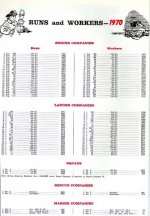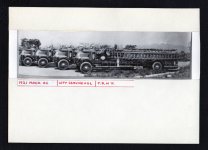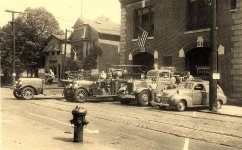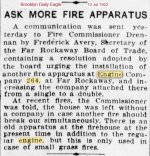- Joined
- Jun 27, 2007
- Messages
- 3,733
During the War Years how were the second sections of Ladder companies, such as Ladder 26, dispatched? Both respond on a job in their still area or did they alternate.
All second sections throughout the city switched from front to back or vice versa at 9AM each day.
Engines 217 & 217-2 worked as follows:
All old first due boxes became first and second due with the front piece first due.
All old second due boxes became second and third due with the front piece second due.
All old third due boxes stayed third due with only the front piece responding.
The Engines in the area that were second due and replaced by the back piece came off the card.
The Engines in the area that were Third due and replaced by the back piece came off the card
You could take a Brooklyn box like 901 at Lewis and Gates. Engines 217 & 217-2 were first and second due.
Eng.214 was blocks away but came off the card. and wouldn't respond if the whole block was burning.
This was to keep the numbers down to a respectable level.
The section up front also went on multiple alarms and relocations.







Thanks Lucky. The R&W numbers from the 1970s reflect that rotation.
View attachment 15913
There were also several eras when FDNY used 2nd sections, combined engine companies and combined companies which had different purposes for forming multiple sections and different response assignments.
There were expansion periods when NYC grew in the late 1890s and FDNY incorporated Brooklyn and LIC paid departments and replaced many volunteer departments. FDNY used Combined Engine Companies to replace former engine and truck companies in less built-up neighborhoods with combined FDNY engine companies. Those sections responded together.
An example: Engine 44 and Ladder 16, paid Brooklyn Fire Department Companies organized in 1895 on W 15th Street in Coney Island became FDNY fire companies in 1898 when Brooklyn became part of NYC. FDNY combined the previous BFD engine and Truck companies and formed Combined Engine 244. This is an unusual 1921 picture of the truck section of Combined Engine 244 in Coney Island. The truck is painted with H&L 244 markings even though it was a section of a combined engine company and there was never a Ladder 244:
View attachment 15914
E 244 former firehouse:
View attachment 15916
Another example of 2nd sections in the early1900s: Many firehouses which were not close to near-by companies also had 2nd engine sections organized in the 1900s to provide appropriate 1st due response. Sheepshead Bay Engine 246, for example, had 2 engine sections, and the 2nd section later became Engine 327. Coney Island Engine 245 also had a 2nd section for many years which became Engine 326 in the same W 8th Street firehouse. Many other Brooklyn and Queens companies had 2nd sections for long periods in the 1900s. These companies would have responded together on assigned boxes.
Engine 245-1, Engine 245-2, H&L 169, Bn 43:
View attachment 15922
Engine 264 in Far Rockaway was an example of another 2-section engine company due to distant location.
View attachment 15923
Firehouse originally had an engine and a truck in 1913:
View attachment 15924
There is also a similar history of 2 section battalions which took place during the War Years. Battalion sections rotated as described by Lucky.
Example Battalion 44-1 and Battalion 44-2 in 1966. Combined, they had 9195 runs in 1966:
View attachment 15925
Somehow I knew that when I posted that question Mack would supply the information, as well as other informed members.Thanks Lucky. The R&W numbers from the 1970s reflect that rotation.
View attachment 15913
There were also several eras when FDNY used 2nd sections, combined engine companies and combined companies which had different purposes for forming multiple sections and different response assignments.
There were expansion periods when NYC grew in the late 1890s and FDNY incorporated Brooklyn and LIC paid departments and replaced many volunteer departments. FDNY used Combined Engine Companies to replace former engine and truck companies in less built-up neighborhoods with combined FDNY engine companies. Those sections responded together.
An example: Engine 44 and Ladder 16, paid Brooklyn Fire Department Companies organized in 1895 on W 15th Street in Coney Island became FDNY fire companies in 1898 when Brooklyn became part of NYC. FDNY combined the previous BFD engine and Truck companies and formed Combined Engine 244. This is an unusual 1921 picture of the truck section of Combined Engine 244 in Coney Island. The truck is painted with H&L 244 markings even though it was a section of a combined engine company and there was never a Ladder 244:
View attachment 15914
E 244 former firehouse:
View attachment 15916
Another example of 2nd sections in the early1900s: Many firehouses which were not close to near-by companies also had 2nd engine sections organized in the 1900s to provide appropriate 1st due response. Sheepshead Bay Engine 246, for example, had 2 engine sections, and the 2nd section later became Engine 327. Coney Island Engine 245 also had a 2nd section for many years which became Engine 326 in the same W 8th Street firehouse. Many other Brooklyn and Queens companies had 2nd sections for long periods in the 1900s. These companies would have responded together on assigned boxes.
Engine 245-1, Engine 245-2, H&L 169, Bn 43:
View attachment 15922
Engine 264 in Far Rockaway was an example of another 2-section engine company due to distant location.
View attachment 15923
Firehouse originally had an engine and a truck in 1913:
View attachment 15924
There is also a similar history of 2 section battalions which took place during the War Years. Battalion sections rotated as described by Lucky.
Example Battalion 44-1 and Battalion 44-2 in 1966. Combined, they had 9195 runs in 1966:
View attachment 15925
Horse drawn era 2nd sections:Thanks Lucky. The R&W numbers from the 1970s reflect that rotation.
There were also several eras when FDNY used 2nd sections.
1900's 2nd sections:Thanks Lucky. The R&W numbers from the 1970s reflect that rotation.
There were also several eras when FDNY used 2nd sections.
Another example of 2nd sections in the early1900s: Many firehouses which were not close to near-by companies also had 2nd engine sections organized in the 1900s to provide appropriate 1st due response. Sheepshead Bay Engine 246, for example, had 2 engine sections, and the 2nd section later became Engine 327. Coney Island Engine 245 also had a 2nd section for many years which became Engine 326 in the same W 8th Street firehouse. Many other Brooklyn and Queens companies had 2nd sections for long periods in the 1900s. These companies would have responded together on assigned boxes.
War Years 2nd sectionsDuring the War Years how were the second sections of Ladder companies, such as Ladder 26, dispatched? Both respond on a job in their still area or did they alternate.
Thanks Lucky. The R&W numbers from the 1970s reflect that rotation.
There were expansion periods when NYC grew in the late 1890s and FDNY incorporated Brooklyn and LIC paid departments and replaced many volunteer departments. FDNY used Combined Engine Companies to replace former engine and truck companies in less built-up neighborhoods with combined FDNY engine companies. Those sections responded together.
An example: Engine 44 and Ladder 16, paid Brooklyn Fire Department Companies organized in 1895 on W 15th Street in Coney Island became FDNY fire companies in 1898 when Brooklyn became part of NYC. FDNY combined the previous BFD engine and Truck companies and formed Combined Engine 244. This is an unusual 1921 picture of the truck section of Combined Engine 244 in Coney Island. The truck is painted with H&L 244 markings even though it was a section of a combined engine company and there was never a Ladder 244:
